#italian medieval armor
Explore tagged Tumblr posts
Text
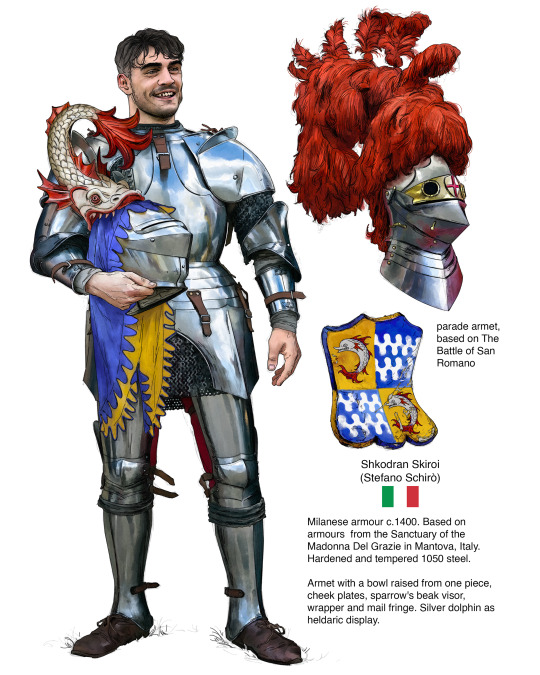
following my other guy (x) now I gotta do the rest of my eurochad ocs in their armour 🐬🐬i blame you @scumpatrol for this!
#ocs#my oc art#oc art#knight#plate armor#armour#milanese knight armor#italian medieval armor#jousting armor#knightcore#arms and armor#artist on tumblr
193 notes
·
View notes
Text
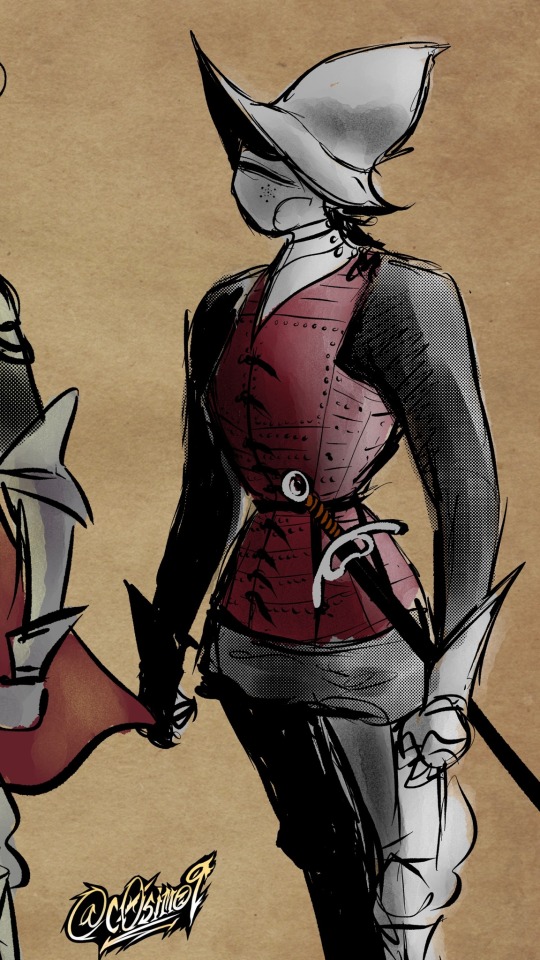
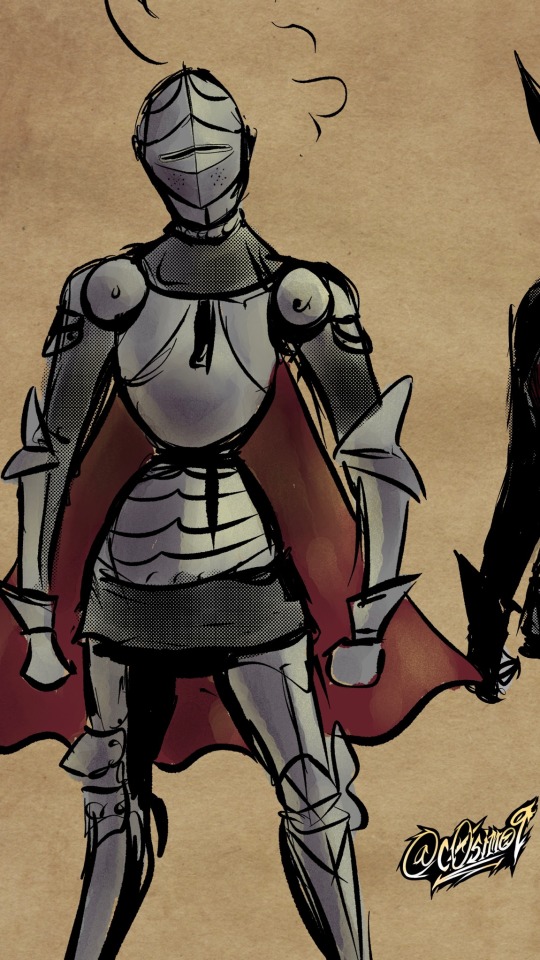
Some 15th century armor sketches
#medieval#armor#15th century#Italian armor#HEMA#kettle hat#armet#chainmail#chainmaille#maille#medieval mercenary#plate armor#xv century#brigandine#milanese#knights#knight#medieval knight#late medieval
91 notes
·
View notes
Text

Horse Armor Probably Made for Count Antonio IV Collalto (1548–1620) | Italian, probably Brescia | ca. 1580–90 and later
#armor#etched armor#engraved armor#antique#antique armor#Italian armor#horse armor#the metropolitan museum of art#museum#art#16th century#17th century#classic art#art details#metal#metal art#metalwork#armory#ornate armor#plate armor#steel armor#post-medieval#renaissance#steel
29 notes
·
View notes
Text

St. George and the Dragon by Carlo Crivelli, Italian, 1470
42 notes
·
View notes
Text

Graafschapsfeesten Horn
10 notes
·
View notes
Text
Drawfee Bits Wrapped (2023)
Cats (2019)
Episodes referenced: 14 (14.89%)
Episodes not referenced: 80 (85.11%)
First reference: January 17
Last reference: November 30
Longest streak of no references: 20 episodes (June 1–August 24)
Shortest streak of no references: 0 episodes (Referenced in the September 14 and 19 episodes)

Cascada (2005)
Counting for Cascada started on August 15.
Episodes referenced: 8 (22.22%)
Episodes not referenced: 28 (77.78%)
First reference: August 15
Last reference: December 26
Longest streak of no references: 12 episodes (August 22–October 3)
Shortest streak of no references: 0 episodes (Referenced in both the August 15 and 17 episodes; then again in both the October 12 and 17 episodes)

Combined statistics
Again, note that this only covers August 15 onward.
Episodes where both were referenced: 2 (5.56%) (October 12 and November 30)
Episodes where only one was referenced: 10 (27.78%)
Episodes where neither was referenced: 24 (66.67%)
Other Notable Bits of the Year
This is a list I kept this year of the most enduring bits, but it's obviously biased.
Fight Song (Origin: Patreon Bonus Stream 03/24/2023)
Italian Cold Steel Cinquedea (Origin: Turning Words Into Drawings)
Merobiba (Origin: Turning Medieval Words Into Art)
So do, Scooby (Origin: Turning Monster Hunter Armors BACK Into Monsters)
#also please feel free to add on your favorite fan creations of the year -- there were so many good ones!!#thank y'all for hanging out with me this year and making this so much fun :)#thank you for the kind words and the corrections most especially!#drawfee#not an episode count#charts and data#year in review#long post
142 notes
·
View notes
Note
As of today, if you had a nickel for all the times Joan of Arc was shown as a magical girl you'd have four, as far I know:
Kamikaze Kaitou Jeanne: a 1998 manga with anime adaptation, it features Joan's reincarnation in the modern day on a mission from God, stealing magical chess pieces to foil the devil's plan.
Puella Magi Madoka Magica: the final episode of the original series, aired in 2011, shows Joan on the pyre as one of the magical girls rescued by Madoka. The manga Puella Magi Tart Magica (with the name Tart being taken from the original spelling of her name, Jehanne Tart) was eventually made, detailing her story and ending with Joan on the pyre as Madoka is coming for her.
Miraculous: Tales of Ladybug and Chat Noir: Joan first shows up in the season 1 finale, with her image appearing on a stained glass window facing a goddamn' dragon. The actual Joan gets time displaced and briefly meets Marinette in "Ephemeral", and her ghost is summoned in "Reunion".
Giovanna Pulzella: a song from Italian parody band Bardomagno released on October 25 2024, the video shows her going from a "normal" maiden that hears the voice of God into a warrior as a magical girl transformation that gives her armor and a new haircut.
Now, how historically accurate are they?
Kamikaze Kaitou Jeanne: Not in the slightest. They took the bare bones of Jeanne's tale and adapted it to a phantom thief story, throwing the magical girl thing in to make it work and going utterly against the actual history while accidentally getting the medieval Catholic idea of purity of a woman right.
PMMM: Extremely accurate down to her haircut (though incorrectly showing her as a blonde), and featuring a lot of historical character in the proper time and action with a single exception justified by virtue of being Perenelle Flamel (that is someone said by folk tales to be immortal), though with a few poetic licenses due the magical girl setting. Especially notable her banner (preserved after her capture but destroyed during the French Revolution), based on historical descriptions except for Kyubey (that Joan thinks is an angel) replacing Jesus, prompting those who see it to comment on how ugly it is (and explaining why descriptions differ), and her reaction of awe to a Soul Gem (by Catholic doctrine the body is merely a container of the soul, so being suddenly able to TOUCH her soul is taken as proof of the Incubator's divine power).
Miraculous: mixed bag, and irritating. For starters it's the only time they presented her with her historical black hair, if with a cut contrary to descriptions preceding her prisony. In "Ephemeral" she calls for Bertrand de Poulengy, a French knight historically known only for being her follower from BEFORE meeting the Dauphine Charles to her rehabilitation trial, only to follow it up with her attacking with her sword when her own testimony at the heresy trial, confirmed by witnesses at the rehabilitation trail, explain she never used the sword in combat, only as decoration and to chase prostitutes out of the camp (and breaking one on the back of one of the prostitutes). And in "Reunion" her ghost (by some accident identical to how ghosts were seen in the Middle Ages, as an image of the soul of a defunct left in the world to help the living or made by the devil to tempt them) shows her famous temper and references how the French throne was in fact vacant from the death of Charles VI in 1422 to the anointment and coronation of Charles VII in 1431 (long story short one could truly be King of France through the coronation in Reims and needed to be a knight for it, but the city was in English hands until retaken by Joan and Henry V was below the minimum knighthood age), only for her devotion to God (great enough she was eventually made Saint Joan) to go unmentioned and her devotion to France being ignored for a trite romantic plot that included Charles VII and Henry V being presented as warmongers prolonging the war for their own ambition IN DIRECT CONTRADICTION TO INFORMATIONS SHE HAD MENTIONED EARLIER IN THE EPISODE (when she was asked who was King of France in 1423 and she started explaining why the answer was "no one").
Giovanna Pulzella: Quite accurate except for the jokes (it's a parody band, after all), as expected by Bardomagno, whose members are all history buffs. Just don't ask why Charles VII is shown as looking like the main character from the old manga Kaibutsu-kun, that's one pun for older Italians that would make Chat Noir groan.
And if you ask me, when the magical girl manga and the parody band that are both taking artistic licenses make a better job representing Saint Joan than the guy who supposedly is a fan of the Maiden of Orleans, one has the right to be angry.
It's a bit of a mess
18 notes
·
View notes
Text
Okay so a second take on your question,@themousefromfantasyland ; because my first answer was a bit of garbage (I am not good at making answers out of the blue).
What counts as a fairytale? What is a fairytale?
The most limited and narrow definition you can have are the classical works explicitely referred to or written as fairytales: "contes de fées" in French, "märchen" in German. This means the traditional stories of Perrault, Grimm and the like. And in this narrowest definition you can go even more narrow depending on which side of the "purists" you are. Some are strictly focusing onto folkloric fairytales and folktales, and thus reject literary fairytales like Perrault's or Andersen's ; others will defend that the fairytale genre was a literary invention first and foremost, and will classify Grimm or Joseph Jacobs' work as folklorism. And this raises the question of the Italian fairytales, Straparola and Basile, the Pentamerone and the Facetious Nights: are they fairytales, or proto-fairytales? Because the term "fairytale" was invented by late 17th century France, "conte de fées", and as such, can stories written before that be considered truly fairytales? For some these Italian stories are proto-fairytales, for other full fairytales. But you get the idea.
On the other side of the spectrum of "What is a fairytale?" you have Bill Willingham's approach through Fables. Aka: everything is a "fable". In his fictional world, fairytales and folktales are just the most prominent and famous of those "fables", but they also include all forms of folklore and mythologies in the world ; all literary works that had a deep cultural impact (from Arthurian tales to Sleepy Hollow) ; and even urban legends and modern folklore. Basically, any type of fiction is a "fable"...
And honestly, expansions and overtures are perfectly possible between those two extremes. The entire question is: can you justify this expansion? And what tone will it give your fairytale selection?
If we consider a "fairytale core" made of all the classic literary and folkloric fairytales... And I am not talking here about extending fairytales to other folktales or to literary imitations, pastiches or parodies. But rather...
Can one include the Arthuriana and Arthurian tales into fairytales? Certainly! Because an entire branch of French literary fairytales, starting with madame d'Aulnoy and others, the famous "knight in shining armor, and princess in a tower, and dragon to be killed" type of fairytales, was inspired by Arthurian romans and medieval romances and other medieval tales of knights such as in the lais of Marie de France.
Can one include Greco-Roman mythology, or Norse mythology, in fairytales? For sure! French literary fairytales were also heavily inspired by Greco-Roman mythology ; fairytales of Nordic countries rather have roots in Norse mythology (trolls and dwarfs and elves) ; the oldest depictions and "prototypes" of famous fairytale types are always found in mythologies (Psyche's tale is the mother of a good bunch of fairytales, I might make a post about it)...
Can one include "fables" as in Aesop's fables or La Fontaine's fables in fairytales? Yes! Because there was a historical confusion for a long time between "fables" and "fairytales" meaning the two were very often confused.
Can one include nursery rhymes in fairytales even though they have nothing in common? Yes! Because in the British literature and culture, figures such as Jack, the goose with golden eggs, or Mother Goose, ended up forming a bridge and common element between fairytales and nursery rhymes.
Can one include famous children fantasy, or very influential children-works involving magical elements? Yes, it is possible! Because these stories were often heavily inspired by fairytales, or use fairytale tropes and codes, or were deconstruction of fairytales. The Wizard of Oz was originally written as the "first American fairytale", while trying to deconstruct typical fairytale cliches. Disney itself helped cement and spread around the idea that some famous children literature or children fantasy works were tied to fairytales (Pinocchio, Alice or Peter Pan, among others).
Can things such as the medieval Reynard cycle be considered part of fairytales? Yes, again! Because the stories of the Reynard cycles are also found around and across Europe as either "animal fables" or as "animal folktales" (the big classifications of folktales has an entire section for animal folktales, which are just Reynard stories with the name of the characters removed) ; and there is this connection to the folkloric figure of the talking animals (the talking fox or the talking wolf forming bridges).
Can werewolf tales or vampire tales be included in fairytales? Yes! Because there is a lot of folktales that blur the line between the two, and many "folkloric fairytales" that are just vampire tales or werewolf tales...
Honestly, the fairytale genre can be expanded in any direction as long as you have a clear justification and a clear goal in mind. The walls of folklore and fiction are thin and movable, and it is for you to build your maze of tales. Anything is possible.
But in return, are you forced or obliged to add all this to your fairytales? Certainly not! A fairytale means something different for everybody, everyone has different references, everyone has a different approach to folklore or had different childhood experiences. As such, some people will agree for example that yes, Dracula or Frankenstein can be mixed very well with traditonal fairytales, while others will scream they have nothing in common. Some will feel it is natural to have fairytales as expansions of old mythologies, while others will prefer keep them separate. Some dislike having modern works like Oz or Narnia or the Alice in Wonderland stories be confused with traditional Perrault or Grimm fairytales ; others dig it and were raised on the idea they were all the same.
It is all a question of personal appreciation, and honestly there is no way to go wrong with this... As long as the person who does this knows what they are doing, why they are doing it, and has some knowledge of the original material, and doesn't just do things out of misinformation or "Well everybody does this, I'll do it too without thinking much about it".
36 notes
·
View notes
Note
Fun facts about the Crusades?
Today You Learned about Frederick Barbarossa.

I wasn't planning to use his profile pic from Wikipedia, but I just thought it looked kind of funny.
Born in 1122, Friederich I, nicknamed 'Barbarossa' because of his red beard, was the Holy Roman Emperor. This dude has a reputation as a badass. See, the Holy Roman Empire (not the same as the Roman Empire you probably think of) wasn't quite as awesome as it had been in the past, so Friedrich wanted to fix that. Upon ascension to the throne, he solidified his power base, did international politicking like a pro, made friends with the Pope (though his relationship with the Papacy later turned sour), and proceeded to wage several major campaigns in northern Italy to re-establish Holy Roman presence there.
He grabbed the relics of the Three Magi and put them in Cologne, Germany, where they're kept to this day. He worked hard to get Charlemagne canonized--which kind of happened, by an antipope though, so it doesn't actually count for us Catholics. He built a friendly rapport with the Byzantines. And then he built tons of family connections by getting kids hitched to Italian nobles.
Also! Fun fact: while he later put a tax on the Jewish population of his kingdom, he also passed laws protecting them, and punishing anyone who would preach against or harm them. Which in this point of history is mind-blowing.
Dude didn't have a spotless record, but he was a certified badass and experienced statesman.
And then the Third Crusade happened.
After a sermon pitching another Crusade, Freddy Barbarossa asked an assembly if he should take the Cross. The crowd overwhelmingly cheered for it, and so he did, making preparations to go East and free the Holy Land. And this Crusade was going to be AWESOME, right? Three Kings on Crusade: Frederick Barbarossa, Philip II of France, and... some guy from some island people hardly cared about.
[That last one's an exaggeration, but I'm doing it for dramatic effect so stick with me.]
Philip and the other guy decided to sail. Friederich went over land, with an army a hundred thousand strong, with tens of thousands of knights. This was THE SHIZ, man, he was going all out. They had some opposition on the way, because some kingdoms don't like it when you march an army through them! But they pushed through, and this was going to be the Most Awesomest Crusade Evah. Saladin was quaking in his boots.
So, uh... yeah, he stopped somewhere on the way there, and uh... drowned.

Goshdarnit, Friederich.
There are conflicting accounts as to how that happened. Some say he went swimming across the river and drowned in unexpectedly strong currents. One account says he got thrown from his horse and drowned because he was in his armor. Some (including some Saracens) declared it was God's punishment.
Regardless of exactly what happened, we still had a dead Holy Roman Emperor. A lot of his army just packed up and went home. Philip of France saw that the biggest guns for this operation were gone, and decided he's also turn around. Without Frederick Barbarossa, it was going to be a bust.
And so that third guy, that nobody from a backwater? He decided not to go home. He decided, "Screw it! Frederick's dead, and the French are leaving! I'll do this Crusade on my own!" And he did; it made his career (and arguably bankrupted his country). For his role in the Third Crusade, Richard, the last guy standing, was later known as "King Richard the Lion-Hearted".
[Okay, so England wasn't exactly a backwater no one cared about, but it wasn't considered as important as France or the Holy Roman Empire. Richard helped make them more noticeable on the medieval world stage.]
For whatever reason, some people decided that it was difficult to believe that Frederick got himself killed so lamely. So there's a popular German legend that came up in the Middle Ages claiming that he's not dead, he's just sleeping under a mountain somewhere, and will pop back up when he's needed.

Of course, given German history, you can probably guess what unsavory sorts co-opted this story, or the imagery of Frederick as the great warrior king, while also forgetting that he put up historic protections for the Jewish people. The Nazi invasion of the Soviet Union was titled "Operation Barbarossa" after this guy.
Nazis suck and they lie about history. What else is new?
Putting the 'fun' back in 'Fun Fact', Barbarossa's death is also a major Plot Point in the novel Baudolino by (the notably anti-fascist) Umberto Eco, where it's turned into a bit of a mystery. Also there's a lot of weird stuff in that book, and Barbarossa's death is maybe the least weird thing going on.
Hope this was an enlightening Fun Fact for you!
#Fun Fact Friday#Today You Learned#Crusades#this wasn't meant to be this long#medieval#Frederick Barbarossa#Third Crusades#history
7 notes
·
View notes
Text

Dear Gus & Magnus,
We got lots of steps again today. We stopped by "the bean" and Millennium Park on our way to the Art Institute of Chicago. At the park, the symphony was rehearsing for a concert they have Friday night. We watched rehearsal for a bit, and I took a video to send to Magnus. (Nene said he said, "Where are the trumpets?") We stopped into an Italian place for lunch before going to the museum.
We didn't enjoy the museum as much as we thought we would, mainly because the galleries didn't really flow into each other. We spent a lot of time trying to figure out where we were and how to get to the next gallery. But we did see some really cool pieces. We both liked "American Gothic" the most. And I got into their collection medieval weapons/armor.
Dinner at Elske was really good, but not quite as good as Jeong.
Dad.
Chicago, Illinois. 7.11.2024 - 4.09pm.
#liz choate#art institute of chicago#chicago#art#modern art#a sunday on la grande jatte#georges seurat#paintings
2 notes
·
View notes
Text

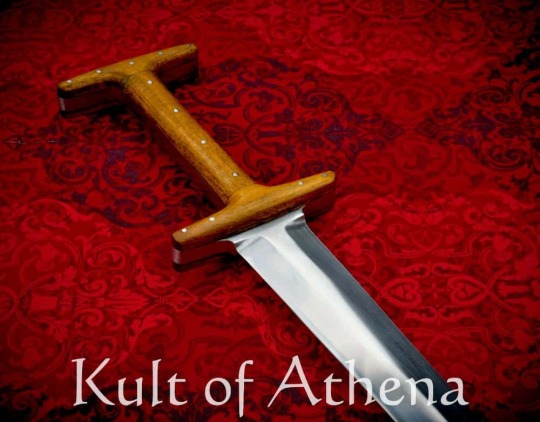


Tod Cutler – English / Italian Baselard 14th – 15th Cent.
This Baselard from Tod Cutler has a rigid blade of tempered EN45 high carbon steel and a very thick and reinforced tang and the grip is formed from polished wood scales which are sturdily pinned and directly to the tang for a secure construction. The dagger is paired with a durable sheath of quality leather with stitched construction, lacing to tie it to a belt and a finishing chape of brass.
A very popular Medieval dagger that could be found from Scotland to Italy and all places between. The Baselard had some regional variations and the one reproduced here by Tod Cutler is of a style popular in Italy and England. The broad H-shape grip gives a secure handhold and gives plenty of support for the thrust or make a disarm much more difficult. The blade is stiffened at its base with a hexagonal cross section which transitions to a diamond cross section. The long and stiff blade is designed to puncture handily through thick clothing or to be used as a lever to work its way into and through the weakpoints of an armored harness.
#Kult of Athena#KultOfAthena#New Item Wednesday#Tod Cutler#English / Italian Baselard#English / Italian Baselard 14th – 15th Cent.#Baselard#15th century#14th century#Knife#Knives & Daggers#Knives#Dagger#Daggers#European Knives & Daggers#Medieval Knives & Daggers#Renaissance Knives & Daggers#English Knives & Daggers#Italian Knives & Daggers#European Weapons#Medieval Weapons#English Weapons#Renaissance Weapons#EN45 High Carbon Steel#Battle Ready
4 notes
·
View notes
Text
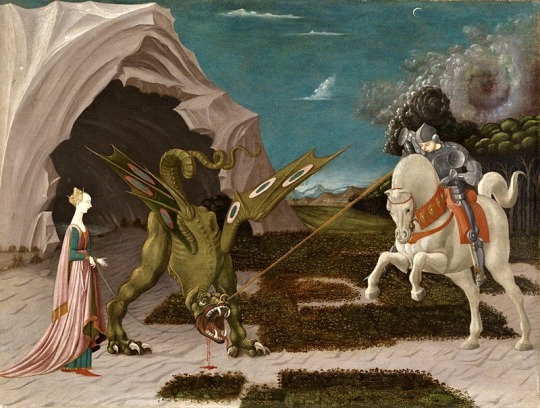
St. George and the Dragon by Paolo Uccello, Italian, ca. 1470
7 notes
·
View notes
Text

Armour off body. I suspect this in not how they actually stored these things.
The maille at the ankles of the greaves are is interesting.
UBK 2° Ms. poet. et roman. 3 Giovanni Boccaccio, folio 047r. 1425-1450, Northern Italy.
8 notes
·
View notes
Text
Lingshan Hermit: "Self" Politics
I don't know when it started, it seems like since the beginning of consciousness, the "self" has accompanied us. We seem to naturally believe that the self exists, we naturally believe that it is me, I am it. Everything we see and hear around us only reinforces this belief - almost everyone believes this. But is all this really true?
Just like people living in North Korea, they are born into pervasive propaganda. They take for granted that everything is the way it is. In those countries, a minority of people take on the duty of brainwashing the masses, but on the issue of self, all people are constantly brainwashing themselves and those around them. Every day we reinforce the selves of ourselves and those around us. Bodhisattvas do the exact opposite. The core of a Bodhisattva's work is to loosen, dismantle, chip away at, or even forcibly demolish your self.
The "self" is like certain pseudo-political regimes, it claims to represent us, it claims to act in our best interests, it claims that it is us. When it encounters blows, we feel completely justified in getting angry. But it is not us, think about it, our whole lives we work for the self, we defend every inch of its territory, we cannot tolerate any disrespect towards the self, everything we do is to maintain it. (Think carefully, you have almost no second that you are not under its control, everything you do is to preserve it) In the end what do we get, other than a pile of bad karma and a pile of vexations, pains and suffering, you gain nothing.
You spend your whole life busy satisfying the self's various needs, from mental to physical, you wrongly believe that satisfying the self will bring happiness. But because our true nature is no-self, the self has never felt secure, no matter how much mental and physical satisfaction you have, the self is still not satisfied, you always feel the next thing will satisfy me, but this is just your fantasy. The self obtains temporary security through endless grasping, but the more you grasp, the more insecure the self feels. It's like addiction.
Think about it, you almost never have moments without grasping. When alone, if your eyes do not look at something, you feel panic. Your self feels it has no foothold, it will surely compel you to grasp at something. The self must rely on something to gain a sense of security (or "existence"). The self must extract nutrients this way, it itself does not exist, precisely because it does not exist, it tries to prove its existence, the way of proving is by establishing a subject-object duality with others and the environment, gaining a sense of security and existence. As soon as we do nothing, the self feels suffocated, it will spur you to grasp at something, look at something, listen to some sounds, feel something, in order to continue surviving.
The "self" is like the knight in Italian writer Italo Calvino's novel "The Non-Existent Knight". This knight wears medieval armor, but there is nothing inside, he never takes off the armor, because once he takes it off, he disappears. He seems able to fight, flirt with women, but underneath the pile of armor, there is nothing. The self is just like this, it seems formidable, but in reality it is just a pile of fake masks stacked together.
As people fooled by the self, we are not as smart as we think, many people feel they cannot be fooled by certain political regimes, but it is impossible for them not to be fooled by the self. Basically, we are fooled by the self every day, we defend the self every day, we express loyalty to the self every day, this shows you are the "self's" peasant.
As a peasant under the rule of the self, you may feel you are thinking independently and judging independently, but in fact you have never escaped the vision provided by the self, it makes you think however it wants you to think. It makes you do whatever it wants you to do. It makes you see whatever it wants you to see. You have never broken free of the self, never perceived the world beyond the self's control. As Chogye Trichen Rinpoche said: every minute and second of our lives we completely believe this perception. This perception is provided by the self.
From this perspective, ordinary beings like us are no different from those living in North Korea. They don't know that what they staunchly defend is the very culprit causing their suffering, just like we don't know.
You are fooled by the self. Being fooled by the self is not much different from being fooled by a dictatorial regime. Their methods are similar. Even the way the self sabotages your spiritual practice is very consistent with how a dictatorship maintains its rule. The self keeps you under total surveillance, it has installed countless cameras on you, any aberrant behaviors cannot escape its eyes. If you want to practice the Buddhadharma, for the self, nothing could be more serious, this is tantamount to you plotting a coup, meaning it could be overthrown by you.
The self panics, but soon, the self realizes you are not serious, you just want to dabble, the self is very welcoming of this kind of practice. The self absorbs the theories in Buddhism and provides interpretations that ensure the "self" will not be harmed. For example, the self likes theories like "life itself is practice". The self also likes theories like "live in the present moment", "meditation is doing nothing". The self strongly promotes these theories and gives absurdly wrong interpretations. We are happy to accept these kinds of interpretations, so we just continue our old ways of life, never practicing, because "life itself is practice". The self appreciates this kind of practice, is happy to see this kind of practice, and harmoniously coexists with it. Anyone just looking at the surface would think you are a spiritual practitioner, maybe even an exemplary one. Only the self knows you are not. But you don't know. This shows your attempted overthrow of the self failed even before it started. The self is very skilled at sabotaging your practice this way.
But perhaps, your exposure to the Buddhadharma was not to overthrow the self's rule in the first place. In fact, for most people, the motivation to engage with Buddhism is far from overthrowing the self. On the contrary, we approach Buddhism to satisfy the self. Of course, even now, you may not truly understand what the practice of Buddhism has to do with the self.
Why our practice aims to overthrow the self, that is because the self has established an entire system. This system prevents us from truly connecting with things, we cannot connect with the world in a real way. This is the root of almost all our problems. From beginningless time, this system has been running smoothly, this system covers up the entire sky, preventing us from seeing the sunlight. It obstructs us from understanding the true nature, it makes us believe the sky is this color. We think we are living people, but in fact we are just machines programmed by the self with various reactive patterns. When we encounter certain situations we get angry, when we encounter other situations we become happy. We are just that mechanical and rigid. The self controls everything about us, monitors us 24 hours a day, its tentacles reach every aspect of us. As long as this system has no problems, you will never be able to understand the true nature in your whole life. Our so-called practice is actually just regularly interfering with and disturbing the self's operating system, causing it to malfunction and freeze up temporarily. At those times, gaps will appear in the cloud cover, and sunlight will shoot through the cracks in the clouds.
But the self is too crafty, what you understand, it likewise understands, what you know, it also knows, you are fighting with someone who knows you inside and out, you are fighting with your self. It completely understands your every move. When you are making battle plans, it is right there watching. Without the intervention of a qualified teacher, it is hard to imagine you could defeat it.
Lacking the guidance of a true teacher, you can hardly protect any of your practice accomplishments, the self will ruthlessly steal them all away. Being able to truly see through the self's tricks is a decisive factor in a practitioner's success, lacking this factor, all your practice will be hijacked by the self. We should pray we can see through all the tricks of the self, this is even more important than attaining the Great Perfection. But if you want to understand how the self steals your practice, the first thing is to find an excellent teacher. This teacher must know how to prevent disciples from falling into materialism in practice. If a teacher only provides Buddhist knowledge but does not tell you how to protect your practice accomplishments, how to avoid materialism in practice, how to see through the self's schemes, then I tend to think he is not a qualified teacher.
But to be with a true teacher, you must be prepared to be hit at any time. Your "self" will be beaten up without any warning before you are notified, a real teacher will absolutely not give any advance notice before striking.
Because of long-term control by the self, when the "self" gets hit, you feel it yourself. You mistakenly think the one being hit is you. You might even be the first to fight back - you can see how consistent this is with those fooled by dictators. The self will step in at times like this to sow discord between you and the teacher. Because it knows that at normal times, when you and the teacher get along well, sowing discord is useless. Only when you are hurt, for example, when the teacher seems to treat someone else better than you. The self will never miss chances like this, at these times you will think: the teacher doesn't seem to treat me as well. At these times you will give rise to emotions, and the self succeeds. This is how the self sabotages your practice.
Compared to those political deceivers who have fooled millions or even billions of people, the "self" is the greatest deceiver in history. It designed such a magnificent scam, not a single sentient being in the six realms is not a victim, except those who have realized the true nature, not a single being does not live inside the self's scam, whether humans, animals or aliens, hungry ghosts, gods, it created such a grand illusion that makes each of us live inside it and firmly believe its authenticity. Is there a bigger deceiver than the self? Pitifully, every time we are duped, we still choose to continue believing the self.
Up until today, most people still lack an understanding of the self's scam. Aside from the few who have seen through the self's true nature, most people firmly believe in everything the "self" shows them, they firmly believe the world is as they see it, that this is how we should live, they firmly believe defending the self is of paramount importance - including most Buddhists. Their practice has not shaken the self one bit, on the contrary, their practice dances with the self. They seem to be at odds with the self in public, but privately they buddy up with the self, frequently sending flirtatious glances.
Finally, I want to add that the self I spoke of, in the past, present and future, has never actually existed, but regrettably, we believe it exists. Because of this we are caught up in its scam.
First published on Lingshan Hermit's blog on February 29, 2012, copyright belongs to the author, please do not infringe.
Copyright Notice:All copyrights of Ling Shan Hermit's articles in Simplified and Traditional Chinese, English, and other languages belong to the natural person who owns "Ling Shan Hermit". Please respect copyright. Publishers, media, or individuals (including but not limited to internet media, websites, personal spaces, Weibo, WeChat public accounts, print media) must obtain authorization from Ling Shan Hermit before use. No modifications to the articles are allowed (including: author's name, title, main text content, and punctuation marks). We reserve all legal rights. 灵山居士:“自我”政治学
4 notes
·
View notes
Text
MEDIEVAL HELMET TOURNAMENT


The Coventry Sallet is a rare Italian 15th century helmet. It is a 'high crowned' helmet, similar to Great Helms, and was used during the Wars of the Roses. The Kabuto is a type of helmet used by Japanese warriors, later becoming an important part of the traditional Japanese armor worn by the samurai class. The one featured in the image is from the 15th century.
#medieval#medieval helmets#polls#poll#tournament#history#armour#armor#medieval helmet#15th century#samurai#medieval europe#medieval japan#Medieval Posting
3 notes
·
View notes
Text

Your Muses Treasures! Rules: What are your Muses most Treasured Objects? List 3-5 Objects that have a high emotional value for your Muse. Describe their Meaning to your Muse. The Items do not have to be Part of your Muses Inventory! Repost, don’t Reblog. Original @treasurechestrpmemes ! Tagged By: Walter von der Vogelweide Tagging: @alchemaxed @spinxeret @iobartach @goblinfire @wovendeath @sickthem @voltedblood @carnivorousfatality @the-rogue-dragon @h-osborn @books-and-right-hooks @kylo-wrecked @canoncompliance !
Dane Axe + Helmet with Grimme + Hauberk. What might not be noticeable, but the armor Wolf uses in her spiderman costume is very “old”. She wears a helmet of a model based on the Gjermundbu Helmet, the hauberk is a simple one that is pulled over the head instead of beeing opned and closed with belts and with the sleeves only reaching to her elbows, and instead of a sword she uses a Dane axe that obviously came from danemark. Which means that the attire is around 100 years behind the armor used in her time and also destinctively not from around italian, but danish or norwegian. It is because the attire Wolf used for her costume are pieces of armor given to Asada from Travlers as a “Thank you” after they had seeked her out for healing similar to templarknights who had sworn a vow of poverty giving their swordbelt as a payment. But how did old danish / norwegian armor found its way to Pisa? Armor is not as easily remade than one thinks and it is normal to wear helmets that were already worn by the grandparents which roughly amounts to armor beeing 100 years old. So much too the age, but how did this pieces traveled from the North all the way to the south? What should not be forgotten is that it was not the norm in medieval times that a person was born in one place and stayed there their whole life. Journeys were the normal: children were send into other families as help even outside of their homevillage in the European marriage pattern; after all a craftman was after finishing their training forced to go on three years of wandering without returning to their home to learn from different masters which is a tradition still in europe for carpenters, merchants wandered from norwegian until up to China; and even the normal person usually finished their education as a craftman and spend years on wandering as harvest workers /householdhelps until they had collected enough money to buy farmingland and with that money in the backhand be able to marry. The helmet, hauberk and dane axe have a even simpler explination- It were probably a members or a relatives of the Varangian Guard who used Pisa as a port to set over to turkey and seeked Hasna out for healing before leaving the helmet, axe and hauberk with her as a symbolic payment. For Wolf this attire is important because they are tools so she could work as spiderman and therefor are tools so she could help and protect people.
Leatherpouch with strains of different peoples Hair in it. Wolf had been carrying that small pouch around her neck since she had been fourteen years old. Around May of 1212 when Nikolaus Crusade reached the alp the crusade was suppose to cross to reach Genua. Obviously crossing the alps without any food supplies or let alone proper attire ended up in a catastrophe and many of the children either left or died. At this time Wolf had already been traveling with a certaine group of young teenagers with whom she had become friends and for which she had started months ago to steal from and rob people for food for them. The children, very much by now confronted with their own mortality ended up all making such a small pouch with strain of hair of each so in the case they would not survive crossing the alps, a part of them would travel along with their friends.It was also this group of children who brought Wolf into the italian cloister when Wolf fell ill with the pox. Wolf has no idea what had happned with her friends as she was at that time too sick or not able to register what was happening around herself. Years later (1228, Wolf is 30) when Wolf joins Friedrich II as a Medicus and the peace of Jaffa is set, she leaves the small pouch in the Church of the Holy Sepulchre.
A handful of Grosso. After Asada died and was buried, Wolf was seeked out by one of her sons. It turned out Asada not only had a whole family Wolf did not knew about, but this family, at least this son, knew about Asadas life in Pisa and about Wolf as he and his mother had constantly written eachother letters. The son explained that Asada wanted Wolf to be taken care of and had asked her son to take Wolf in as a servant in his household after she had died. Wolf, by now having realized that she needed to help people by beeing spiderman, gently refused. Asadas son left and, as his mother asked himto do if Wolf refused, payed her the amount of grosso that Hasna had payed when she had brought Wolf as a slave: A handful of Grosso in the worth of an old workinghorse. Not enough to buy a property of land and start ones own life, but enough to stay alive for some time. Wolf did nothing of that and joined the convent to make sure she did not needed to touch the money. Its the only thing she has left from Asada .
#I know Wolf and Hasna genuinly loved eachother as family BUT LETS NOT FORGET THAT WOLF WAS HASNAS SLAVE AND THERE WERE REALLY FUCKED UP *#ASPECTS INT HEIR RELATIONSHIP#Wolf is romanticing Hasna#normal reaction considiering her situation#STILL NOT A HEALTHY RELATIONSHIP#NEVER WILL BE A HEALTHY RELATIONSHIP#headcanon#werspinna
3 notes
·
View notes